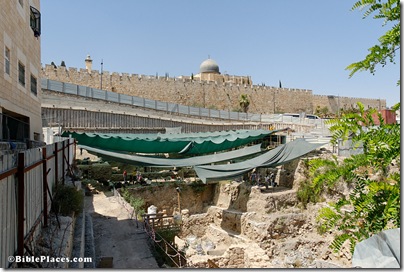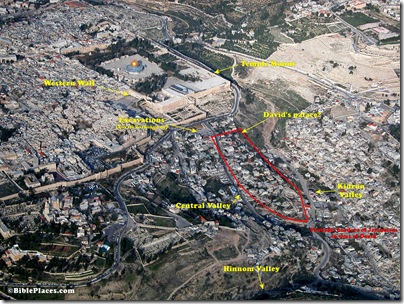Excavations began in the parking lot below Dung Gate in 2003 and were resumed in 2007. The Israel Antiquities Authority has just released a brief report on the discoveries from the 2007 season. It should be noted that this report does not include results from 2008.
The longest portion of the report concerns the Second Temple period, which is primarily the 1st century A.D. It reports one of the discoveries:
A large impressive edifice, whose northeastern corner has only been revealed to date, was in the southern unit. The eastern wall of the building (exposed length over 14 m, thickness c. 2 m, height more than 5 m) was built of large roughly dressed fieldstones, some of which were hundreds of kilograms in weight. The northern wall (width c. 1 m) was also preserved to a substantial height. The interior portion of the building, within the limits of the excavated area, indicated that the structure was divided into elongated halls, oriented northwest-southeast.
This is what was hailed in the media as the “palace of Queen Helene of Adiabene,” though as the 1st century ruler’s name is not mentioned in this report, some may have missed the connection.
The period of greater interest given the current discussion of the nature of Jerusalem in the Old Testament period is the section on the Iron Age, quoted here in full.
The remains of the period, exposed in five strata that represented most of the Iron Age, were founded directly on bedrock, marking the earliest settlement in this part of the City of David. This period was mainly characterized in this area by relatively densely built houses of careless and poor construction. The houses, built of one-stone-wide walls, contained a variety of domestic installations. These indicate a residential quarter that existed in the area during this period.
The early phase of the Iron Age was noted for the use of bedrock the builders had employed for setting the buildings’ walls and incorporating it within their built complex of structures. Thus, ‘habitation pockets’, confined between the buildings’ walls and bedrock outcrops, were discovered. This phase was dated earlier than the eighth century BCE, based on the abundance of ceramic finds. The later phase of this period dated to the seventh–sixth centuries BCE. No building remains from Iron I were discovered.
There are several significant points to note here:
- The discovery of houses from the Iron Age in Jerusalem is unusual. In most places, later destruction removed traces of building except for monumental structure (walls, water systems). The best examples of houses were found on the other (that is, east) side of the City of David in Shiloh’s excavation.
- Caution should be taken before concluding that because some houses in Jerusalem at this time were of “poor construction,” all were.
- Some of the material is “earlier than the eighth century,” which means 9th century (or possibly 10th, but distinguishing pottery between the two centuries is problematic at the moment). This indicates that there was habitation in this area before the expansion in Hezekiah’s day (late 8th century) when the Western Hill was fortified. This should not be surprising, given indications in the biblical text.
- That no remains were found from Iron I (or Bronze Age; see end of report) also fits the biblical narrative. The city of Jebus was small and more closely located to the Gihon Spring when it was captured by David. The city expanded to the north as David prepared for the construction of the temple.
In other words, the biblical account would lead us to expect to find remains earlier than the 10th century in the City of David, remains from the 10th century and later at the Temple Mount, with a likely “filling in” of habitation between the two sometime after the temple’s construction.
Admittedly, there are other possibilities, but this one seems quite reasonable, and it appears to fit with the results of this report.
Readers unfamiliar with the geography of the area and the location of these excavations will better understand the last two points with the graphic below, which shows that the excavation area was outside the boundaries of the “City of David.”


3 thoughts on “City of David Excavation Report”
I think the northern border should be along a diagonal line going from the northeast corner of the red lines, in the direction of the arrowpoint of the Givati parking lot arrow, and stopping a little after it intersects the street. In any case, the Palace of David is a little north of where you have it. You can literally see the southern portion of the parking lot from your photo here.
Yitzhak – thanks for the feedback. I have adjusted the border slightly to the north. I’m not sure that this is precisely where you would put it, but it does now include the entire area of Mazar’s excavation. As you know, there is no evidence for the northern border of the city in this area. Mazar believes that the northern wall is south of the palace she is excavating. Others think it includes the palace. My point in drawing the border roughly was to indicate how these excavations are outside the area generally believed to have been walled during the 10th century.
It is my current understanding Jebus, a very small city originally had no walls but was surrounded by valleys and and had perhaps a millo or rampart of ground and stepping stones at a weak point. All of the pictures and finds seem to overlay David’s walls and fortification of the city Salem.